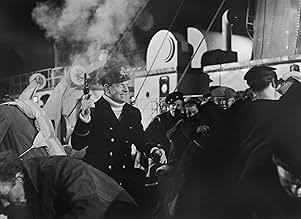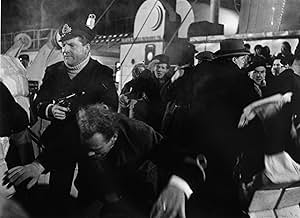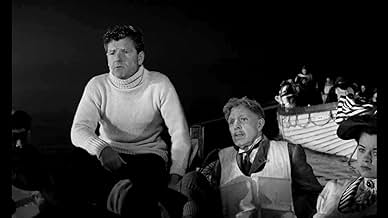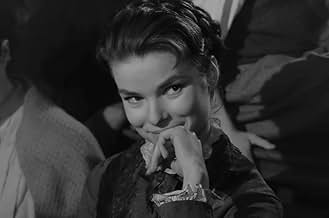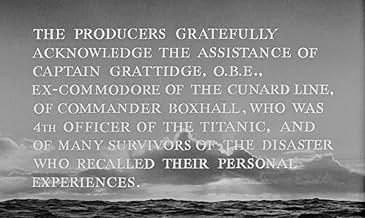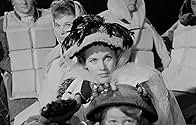Auf ihrer Jungfernfahrt im April 1912 rammt die vermeintlich unsinkbare RMS Titanic einen Eisberg im Atlantischen Ozean.Auf ihrer Jungfernfahrt im April 1912 rammt die vermeintlich unsinkbare RMS Titanic einen Eisberg im Atlantischen Ozean.Auf ihrer Jungfernfahrt im April 1912 rammt die vermeintlich unsinkbare RMS Titanic einen Eisberg im Atlantischen Ozean.
- Nominiert für 1 BAFTA Award
- 2 Gewinne & 3 Nominierungen insgesamt
Empfohlene Bewertungen
That said, this is a riveting and unforgetable docu-drama of this historical event, arguably the most infamous maritime disaster (although loss of life has been greater in other shipwrecks).The fascination lies in the "if onlys".i.e. if only she had been going a few knots slower, if only she had had enough lifeboats for all instead of the maximum laid down by the British Board of Trade in their already out of date 1894 regulations, when the maximum tonnage was deemed to be up to 10000 tons.Titanic came in at 46000 tons.If the weather had been rougher, waves would have broken over the base of the iceberg thus making it more visible.If the crow's nest crew had been given binoculars (they were removed at Southampton).If the Titanic had not been delayed in her construction (and therefore her 31/5/11 launch) by her shipworkers being transferred to the repair in September 1911 of the RMS Olympic following a collision in the Solent with HMS Hawke.If 1st officer Murdoch had steered straight at the berg instead of trying to avoid it the ship may have stayed afloat (although deaths would have occurred by the crumpling of the bow).If the "California's" captain, Stanley Lord had raised wireless operator, Cyril Furmston Evans who had just retired for the night, instead of trying to contact the mystery ship with a Morse lamp.If Alexander Carlisle, marine architect who originally planned 32 lifeboats had not been over-ruled by White Star because it made the boat deck look "cluttered".In fact RMS Titanic ended up with 16 lifeboats, the regulation number required by law, but then White Star actually exceeded the quota by the provision of an extra two Englebert collapsible sided lifeboats with a further two lashed on top of the officers' quarters.If a vital ice message from the "Caronia" sent on behalf of Capt. Barr and received by senior Titanic Marconi operator John Phillips, had gone to the bridge in good time, warning of icebergs directly in the path of the ill fated vessel.And so the "if onlys" go on.
The fascination is of a small Anglo Saxon floating town set in 1912 with all the social classes represented from the aristocratic and rich (first) class, to the professional middle (second) class down to the emigrant and poor (third/steerage) classes - and "never the twain shall meet".The "gilded age", as termed by Mark Twain, had begun in about 1890 and society was marvelling at the wit of man and the many technological innovations and inventions.Perhaps Mankind could outdo Nature but a Greek tragedy was waiting in the wings to punish man for his rash hubris and arrogance.
There is a companion video available called "The making of A Night To Remember" which goes behind the scenes at Pinewood studios and shows the locations used.Actual Titanic survivors were invited as advisors to the Irish producer, William MacQuity, among them were Fourth Officer Joseph Boxhall, Lawrence Beesley, the science master from Dulwich College (who wrote the book "Titanic Its Story and Its Lessons, published by Houghton Mifflin 1912)- a second class passenger who escaped in boat 13.Captain Edward John Smith's daughter Helen stated that the actor Lawrence Naismith who played him, was uncannily like her father as evidenced in contemporay photographs of the two men at approx. the same age.Captain Smith died aged 62, (probably on his last voyage before retirement although this can never be proved).Actor Kenneth More is seen chatting to Sylvia Lightoller the widow of Charles Herbert Lightoller who was second officer,- read his biography "Titanic Voyager".The convincing creaking sound you hear as Andrews tries to sit down in the first class smoking room just before the end, was the actual sound of the hydraulic lifting gear in the studio as it progressively raised the floor.MacQuitty was very careful to ensure the accuracy of the film set angles (of the ever slanting deck as she sank by the bow and rose by the stern), were always matching the dramas recorded by witnesses, so there is a marvellous sense of continuity in the filmed sinking.The B&W photography merges seemlessly with the authentic period film and all the actors convincingly say their lines many based on actual speeches said by the principal characters as remembered by witnesses.This is a superb film.Watch Cameron's "Titanic" 1997 only for the special effects.
These comments on the more recent film are necessary before I can meaningfully report my impressions when watching ANTR Although filmed in monochrome and created with a much more modest budget, ANTR is a film that I will find it very hard to forget. Characterisation of both the passengers and crew seemed to me to be spot on, there were none of the occasional caricatures which jarred so severely in the later film. The drama of the events was left to speak for itself and this created a much more powerful film. The three aspects of the Titanic disaster which have gripped public interest so strongly for almost a century are the sudden impact on a community of 2,000 ordinary people from all stations in life as they gradually realize that they probably only have another hour to live, the impact of the rigid class structures of the period on the way in which this situation was handled both by the passengers concerned and by those in authority, and the enormous number of "what if?" questions that the disaster raised (such as what effect pressure to win the Blue Riband for the fastest Atlantic crossing may have had on the seamanship shown by the officers). All three of these aspects are fully featured in the film, but often in quite subtle ways, and none is given excessive weight. The camera-work and attention to details of presentation, such as the creaking and groaning from the tortured ship, are truly outstanding. Special effects in the 1997 film are admittedly much superior (after all $200 million must buy something!), but those in ANTR are quite advanced for its time and are more than adequate to prevent any serious jarring notes from arising as the film is viewed. Ultimately a film has to be judged primarily by the credibility of the acting and direction, not from the special effects, and I certainly support the view of the majority of IMDb users that these raise ANTR to the status of an exceptionally fine, if not almost unique, movie. A documentary presentation of a major marine disaster which is realistic enough to closely involve most of its viewers will never be everybody's choice of film to watch; but for those who wish to see it, this film will provide an exceptionally rich viewing experience.
Often movies that try to stay close to the facts suffer from a lack of focus, especially when there is/are no central character(s) to hold things together. In this adaptation of "A Night to Remember", they solved the problem by focusing much of the action around Second Officer Lightoller, who was involved in some way in so many different aspects of what happened. As a device it works well, and there is enough action involving the other characters to keep it balanced.
Another inherent challenge in the story is that there are so many characters, and most of them hold some interest. In this adaptation, they chose simply to depict as many brief situations as possible, often without giving much with which to identify the characters. If you are familiar with Walter Lord's book, it is often possible to identify many of them, but otherwise, it might be a little confusing to sort through so many characters.
For such a detail-heavy story, this is an effective and commendable movie. With very few frills, it tells the story believably and sometimes memorably.
It does a pretty good job of meeting the main challenges, not telling the complete story, of course, but providing a worthwhile overview of events.
Unlike the smartingly awful James Cameron schlock boiler, ANTR doesn't pack a spectacular special effects punch - but nor does it pack a spectacularly corny and improbable love story concocted with teenagers in mind. The producers of ANTR understood that you didn't need a fictitious love story to heighten the tragedy of that night - the bitter irony of the real events sufficed.
And it is this irony and tragedy that the filmmakers brought out absorbingly well. The comprehensive book by Walter Lord was consulted down to the letter; so the story is told as authentically as possible. With a great script involving mainly real historical characters, perfect casting, and performances that show the actors were engrossed in their roles, the film really does shine. The snappy, economical directing is both proof of the lack of pretensiousness of the producers, as well as being extremely effective in bringing out the meaning in each scene. This makes for intelligent and gripping viewing.
Watch out for the poignant scenes in which the crew attempt to contact the nearby Californian to no avail, and Captain Smith walks to the railing and implores God to help them; the scene where the Captain calls "every man for himself", then walks into the wheelhouse just before it dips underwater; and the gripping scene in which Thomas Andrews (the Titanic's designer), a broken man, waits in the smoking room for the end, determined to go down with his creation. All these scenes are powerful, authentic and sincere; scenes in which all the various emotions aroused by such a disaster are brought out very clearly and movingly.
The special effects, although not so brilliant for today, were fantastic for the times; half the ship was actually constructed for life-size shooting, and a large model was also built, complete with miniature little row boats featuring motorised oars, for the long shots. So the maximum effort was made to make as realistic a depiction of the disaster as possible. And, in fact, the interior scenes of the ship are perfectly authentic, and the audience feels that they are actually aboard the Titanic. Only in the long shots, where a model was used, does the film look noticeably dated.
So by sticking as close as possible to the survivor's accounts featured in the Walter Lord novel, and by avoiding modern cinematic clichés, A Night to Remember remains the only Titanic film to provide a genuine account of the sinking of the great ship that is not marred by superficial Hollywood garbage. It tells the story, as it happened, of an event that changed mankind's attitudes toward his own creations; and as such, it brings to the screen the full impact of what this disaster really meant to the world in, as mentioned, a very compelling, poignant and honest way. It is a true testament to British film making.
As a footnote, many actual survivors of the Titanic were on set as the film was being made; and the musical pig in the lifeboat scenes was the actual one from the real disaster. In addition, the Titanic's fourth officer Boxhall was a technical adviser to the production. And the film's producer was there, as a small child, when the actual Titanic was launched in Belfast. This kind of authenticity makes this movie almost a living documentary.
Intelligent, honest and compelling, A Night to Remember is at least one of the best historical films ever made, and is well worth anybody's time. Everyone is bound to get something out of this movie; and indeed it is a powerhouse for anyone with an interest in the Titanic or just history in general. A totally underrated gem.
Wusstest du schon
- WissenswertesIt wasn't until 1985, when the wreckage of the Titanic was discovered, that they found out the ship had broken in two while sinking. In this film, the Titanic does not break in two, but goes down in one piece with most of her decks intact.
- PatzerAs with most pictures about the Titanic, filmed before the discovery of the wreck in 1985, this film portrays the Titanic sinking in one piece. The discovery of the wreck revealed that the ship had broken in two, and most films about the ship, Titanic (1996) and Titanic (1997), have reflected this point. Although scholars debate to this day whether the break up happened while the ship was above the water line or while it was under the water, and out of the view of survivors, plunging towards the ocean floor. Eyewitness testimony to the sinking diverges in opinion about this fact, meaning that the movie's portrayal of the ship sinking intact, while above the water line, may not be incorrect.
- Zitate
Mrs. Margaret 'Molly' Brown: Leadville Johnny, they call him. And he was the best golderned gold miner in Colorado! Fifteen I was when I married him.
First Class Passenger: Really?
[in deep upper-class British accent]
Mrs. Margaret 'Molly' Brown: Uh-hmm. And he didn't have a cent. Well, three months later later he struck it rich and we was millionaires. Do you know what he did?
First Class Passenger: No?
Mrs. Margaret 'Molly' Brown: He built me a house and he had silver dollars cemented all over the floors of every room!
First Class Passenger: I say, how very tiresome for you!
- Crazy CreditsJust before "The End", the following is scrolled over a background of the water with flotsam and a life ring buoy with the words "Titanic" and "Liverpool" on it:
But this is not the end of the story ~ for their sacrifice was not in vain. Today there are lifeboats for all. Unceasing radio vigil and, in the North Atlantic, the International Ice Patrol guards the sea lanes making them safe for the peoples of the world.
- Alternative VersionenThe 2012 ITV Studios DVD and Blu-ray features epilogue text at the end as well as the moment with the child.
- VerbindungenEdited from Titanic (1943)
- SoundtracksOff to Philadelphia
(uncredited)
Traditional
Played on violin and sung by Titanic passengers
Top-Auswahl
Details
- Erscheinungsdatum
- Herkunftsland
- Sprachen
- Auch bekannt als
- La última noche del Titanic
- Drehorte
- Great Fosters Hotel, Egham, Surrey, England, Vereinigtes Königreich(Sir Richard and Lady Richard set off from their mansion to board the Titanic at Southampton)
- Produktionsfirmen
- Weitere beteiligte Unternehmen bei IMDbPro anzeigen
Box Office
- Budget
- 1.680.000 $ (geschätzt)
- Weltweiter Bruttoertrag
- 712 $
- Laufzeit2 Stunden 3 Minuten
- Farbe
- Seitenverhältnis
- 1.66 : 1
Zu dieser Seite beitragen



